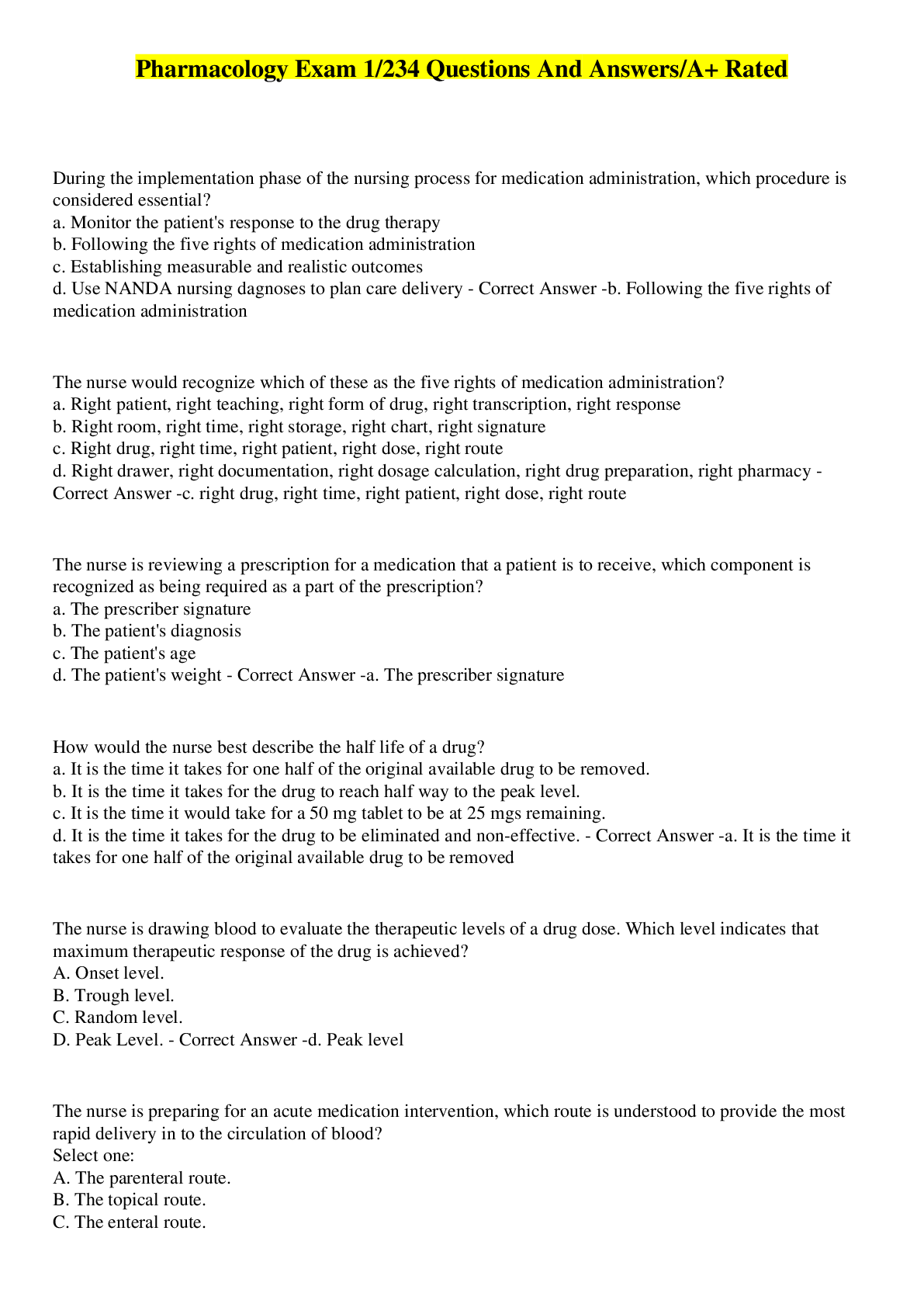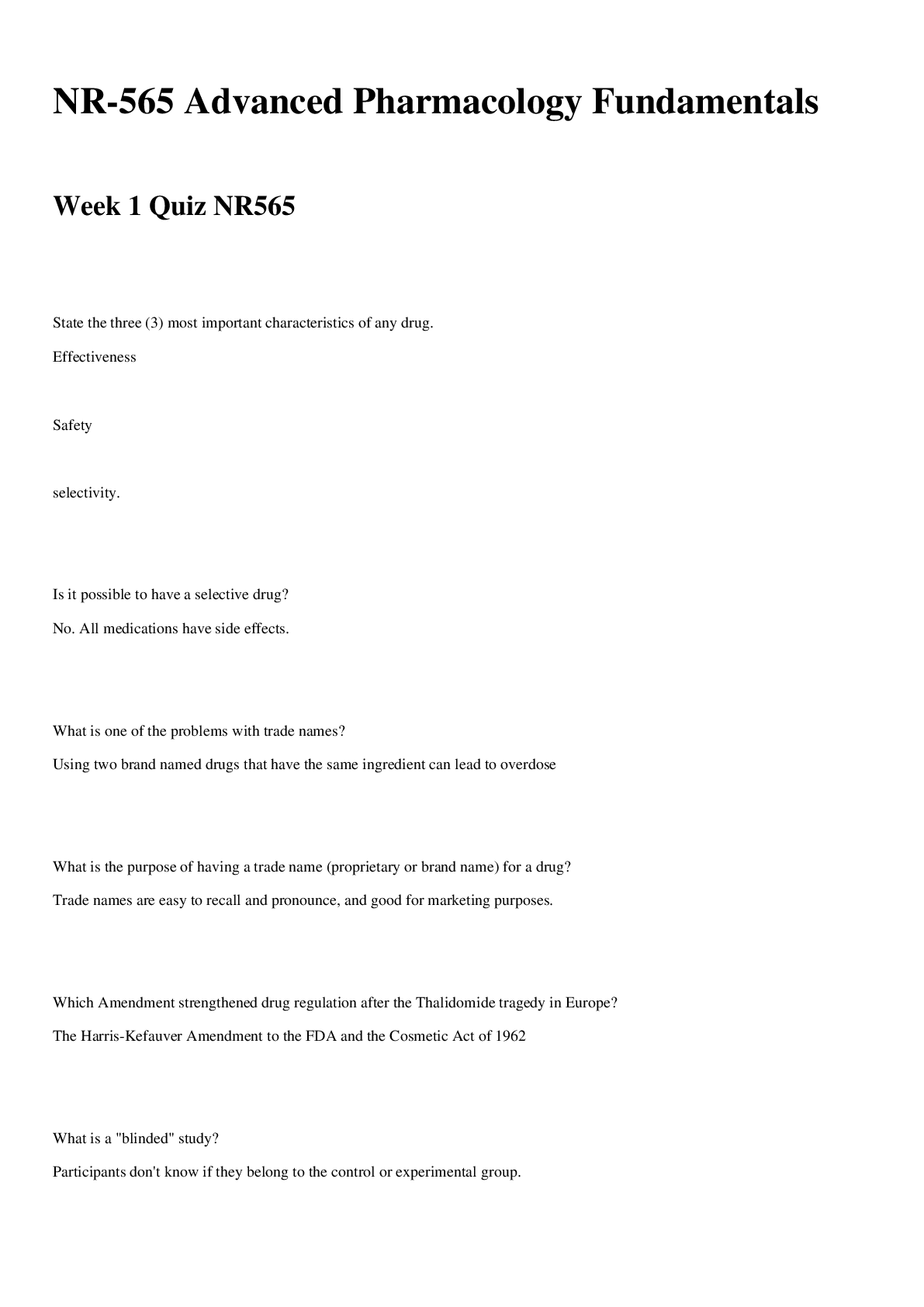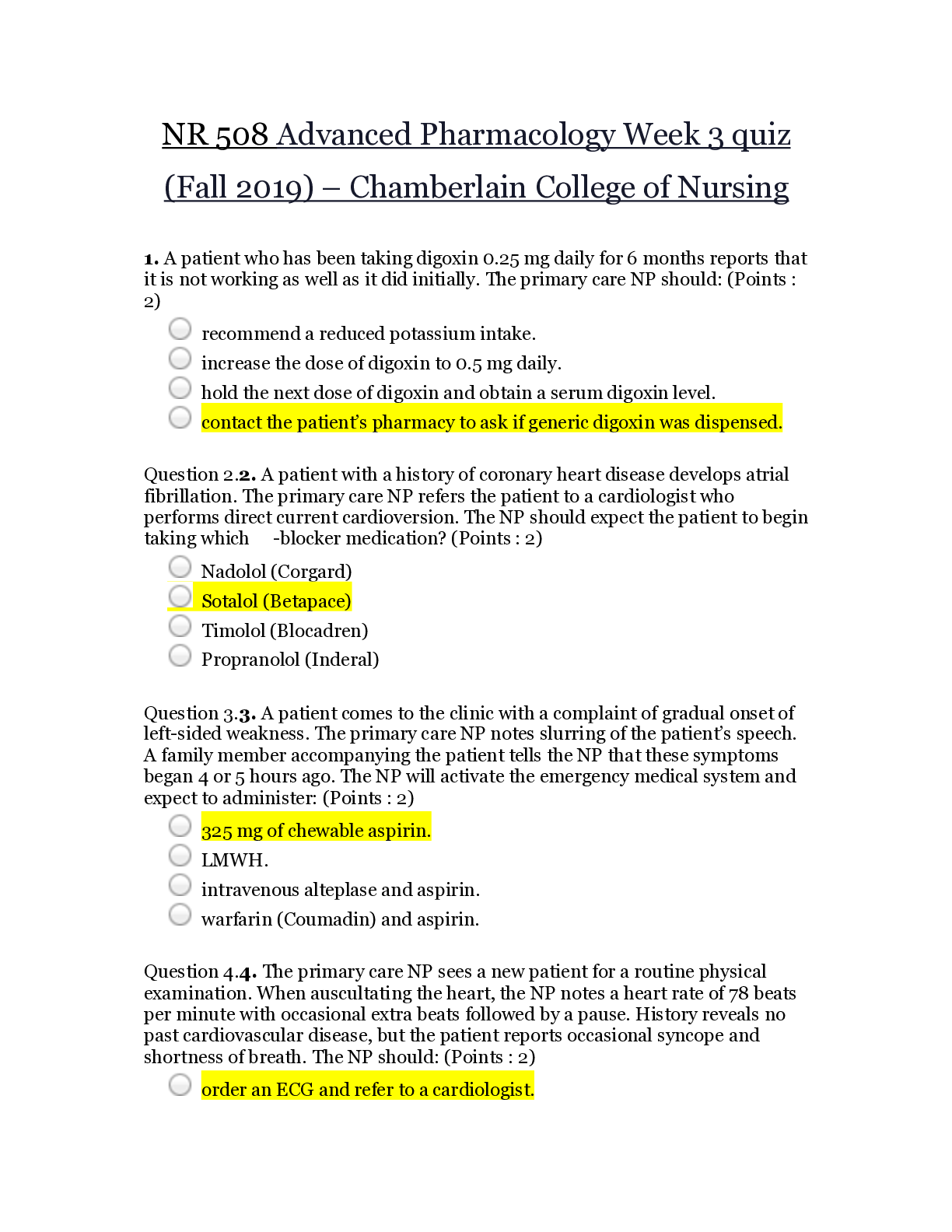Pharmacology > EXAM > NR 508 Advanced Pharmacology Week 6 quiz – Chamberlain College of Nursing / NR 508 Advanced Pharma (All)
NR 508 Advanced Pharmacology Week 6 quiz – Chamberlain College of Nursing / NR 508 Advanced Pharmacology Week 6 quiz
Document Content and Description Below
NR 508 Advanced Pharmacology Week 6 quiz (Fall 2019) – Chamberlain College of Nursing 1. A patient is diagnosed with a condition that causes chronic pain. The primary care NP prescribes an opioi... d analgesic and should instruct the patient to: (Points : 2) wait until the pain is at a moderate level before taking the medication. take the medication at regular intervals and not just when pain is present. start the medication at higher doses initially and taper down gradually. take the minimum amount needed even when pain is severe to avoid dependency. Chronic pain requires routine administration of drugs, and patients should take analgesicsroutinely without waiting for increased pain Question 2.2. A patient who is taking methotrexate for RA sees the primary care NP for an annual physical examination. The patient’s alanine aminotransferase (ALT) and AGT are elevated. The NP should: (Points : 2) decrease the dose of methotrexate. recheck ALT and AGT levels in 2 weeks. contact the patient’s rheumatologist to discuss discontinuing the drug. counsel the patient not to take acetaminophen while taking methotrexate. Liver enzyme elevations are frequent, are usually transient and asymptomatic, and do notappear predictive of subsequent hepatic disease. A decrease in dose or discontinuation of thedrug is not indicated. Coadministration with acetaminophen is not contraindicated. Question 3.3. A patient who has migraine headaches tells the primary care NP that drinking coffee and taking nonsteroidal antiinflammatory drugs (NSAIDs) seems to help with discomfort. The NP should tell the patient that: (Points : 2) this combination can lead to longer lasting headache pain. these substances are not indicated for migraine headaches. doing this can increase the risk of more chronic migraines. an opioid analgesic would be a better choice for migraine pain. Overuse of pain or migraine medications can cause a transformed migraine,which is a long-lasting headache. Following a migraine episode, the patienthas rebound headache daily or nearly daily. NSAIDs, caffeine, opiates, andtriptans can cause these rebound headaches. NSAIDs and caffeine are oftenused to treat migraines. Narcotics and barbiturates increase the risk fordevelopment of chronic migraine headaches and should not be first-linedrugs Question 4.4. The primary care NP sees an adolescent who reports moderate to severe dysmenorrhea. The NP recommends an NSAID and counsels the patient about its use. Which statement by the patient indicates a need for further teaching? (Points : 2) “I should not take this if I think I might be pregnant.” “I should take this medication on a schedule for 2 to 3 days.” “I will begin taking this 1 to 3 days before my period begins.” “I will take this medicine every 4 to 6 hours as needed for pain.” When treating primary dysmenorrhea, NSAIDs should be started 24 to 72 hours before thepatient starts menstrual bleeding. The medication should be taken on a routine basis for 2 to 3days. It should not be taken during pregnancy Question 5.5. A 60-year-old woman has a central dual-energy x-ray absorptiometry with a T-score of 1.9. A health history reveals no risk factors for osteoporosis. The primary care NP should: (Points : 2) prescribe alendronate sodium (Fosamax). counsel her to increase her physical activity. prescribe calcitonin (Miacalcin nasal spray). prescribe supplemental calcium and vitamin D. This woman’s T-score is less than 2.5 and indicates osteoporosis. She should begin treatmentwith a bisphosphonate. Increasing physical activity and taking supplemental calcium andvitamin D are indicated as well but only as part of a medication regimen. Calcitonin is not afirst-line medication. Question 6.6. A 50-year-old white woman who is experiencing menopause asks the primary care NP what she can do to prevent osteoporosis. She has a negative family history and no risk factors. The NP should counsel her to: (Points : 2) consider bisphosphonate therapy in 5 years. undergo bone density testing every 2 years. avoid high-impact sports that can lead to fractures. take supplemental calcium and vitamin D every day. Question 7.7. A patient has been taking an opioid analgesic for 2 weeks after a minor outpatient procedure. At a follow-up clinic visit, the patient tells the primary care NP that he took extra doses for the past 2 days because of increased pain and wants an early refill of the medication. The NP should suspect: (Points : 2) dependence. drug addiction. possible misuse. increasing pain. Unsanctioned dose increases are a sign of possible drug misuse. Dependence refers to anabstinence or withdrawal syndrome. Drug addiction is an obsession with obtaining and usingthe drug for nonmedical purposes. The patient should not have increased pain at 2 weeks. Question 8.8. A patient reports having an acute onset of low back pain associated with lifting a heavy object the day before. Besides advising the patient to rest and apply ice, the primary care NP should prescribe: (Points : 2) an opioid analgesic. metaxalone (Skelaxin) cyclobenzaprine (Flexeril). a nonsteroidal antiinflammatory drug (NSAID). NSAIDs and acetaminophen are first-line analgesic treatments for low back pain. Opioids areused for severe low back pain. The other two medications are not first-line treatments Question 9.9. A patient who is taking an antibiotic to treat bronchitis reports moderate rib pain associated with frequent coughing. The primary care NP should consider prescribing: (Points : 2) morphine. hydrocodone. hydromorphone. oxycodone CR. Hydrocodone is used for cough suppression as well as pain. Morphine can cause profoundrespiratory depression Question 10.10. A patient who has migraine headaches without an aura reports difficulty treating the migraines in time because they come on so suddenly. The patient has been using over-the-counter NSAIDs. The primary care NP should prescribe: (Points : 2) frovatriptan (Frova). sumatriptan (Imitrex). cyproheptadine (Periactin). dihydroergotamine (D.H.E. 45). If the patient is able to take medication at the earliest onset of migraine, ergots are usuallyeffective. Triptans are more effective when patients have difficulty “catching the headache intime.” Sumatriptan begins to work in 15 minutes and so would be indicated for this patient.Frovatriptan has a longer half-life. Cyproheptadine is not a first-line migraine treatment Question 11.11. A patient comes to the clinic and reports recurrent headaches. The patient has a headache diary, which reveals irritability and food cravings followed the next day by visual disturbances and unilateral right-sided headache, nausea, and photophobia lasting 2 to 3 days. The NP should recognize these symptoms as _____ migraine. (Points : 2) classic hemiplegic basilar-type ophthalmoplegic These are symptoms of classic migraine. Hemiplegic migraine is characterized by motor andsensory symptoms. Basilar-type migraine includes vertigo, diplopia, dysarthria, tinnitus, anddecreased hearing. Ophthalmoplegic migraine affects the third, fourth, or fifth cranial nerve,causing permanent damage. Question 12.12. The primary care NP is performing a medication reconciliation on a patient who takes digoxin for congestive heart failure and learns that the patient uses ibuprofen as needed for joint pain. The NP should counsel this patient to: (Points : 2) use naproxen (Naprosyn) instead of ibuprofen. increase the dose of digoxin while taking the ibuprofen. use an increased dose of ibuprofen while taking the digoxin. take potassium supplements to minimize the effects of the ibuprofen. Question 13.13. A 70-year-old patient who has a high fracture risk has been taking alendronate (Fosamax) and calcium for 6 months. The primary care NP orders a urine NTx level, which is 42. The NP should discontinue the alendronate and prescribe: (Points : 2) raloxifene (Evista). teriparatide (Forteo). calcitonin (Miacalcin nasal spray). ibandronate sodium (Boniva). Teriparatide is used in patients with a high fracture risk or in whom bisphosphonate therapyhas failed. Raloxifene and ibandronate are second-line treatments for patients with usualfracture risks. Calcitonin is a last-line treatment. Question 14.14. A patient who has a history of stomach ulcers is taking a nonselective NSAID along with a DMARD for RA. The primary care NP should: (Points : 2) order a glucocorticoid. change to acetaminophen. order a proton pump inhibitor (PPI). change to a selective COX-2 inhibitor. If GI risk factors are present, a prophylactic PPI should be given along with the nonselectiveNSAID. Glucocorticoids make ulcers worse. Acetaminophen is used only for mild pain or asadjunct pain therapy. A selective COX-2 inhibitor has an increased risk of stomach ulcers. Question 15.15. A patient who has mild to moderate migraine headaches has severe nausea and vomiting with each episode. For the best treatment of this patient, the primary care NP should prescribe: (Points : 2) triptan nasal spray. metoclopramide and aspirin. an NSAID and prochlorperazine. sumatriptan and metoclopramide. Administer triptan migraine medication in nasal spray or injection for patients with severenausea and vomiting who have trouble taking oral medications. An antiemetic, such asprochlorperazine or metoclopramide, may be used, although the latter has serious side effects. Question 16.16. A patient is taking 81 mg of aspirin daily to decrease MI risk and uses acetaminophen for mild osteoarthritis symptoms. For flare-ups of osteoarthritis pain, the primary care NP should prescribe: (Points : 2) ibuprofen (Motrin). celecoxib (Celebrex). naproxen (Naprosyn). increasing the dose of aspirin. Concomitant use of an NSAID with aspirin has been shown to reduce the cardioprotectiveeffects of aspirin. However, naproxen does not appear to have this risk Question 17.17. A 60-year-old female patient has begun taking a daily bisphosphonate to prevent osteoporosis and complains of gastrointestinal (GI) upset and dyspepsia. The primary care NP’s initial response should be to: (Points : 2) prescribe a proton pump inhibitor (PPI). order intravenous (IV) bisphosphonates. suggest that she take the drug with food. review the instructions for taking the drug with the patient. Oral bisphosphonates must be taken on an empty stomach, and the patient must remainupright and not eat or drink anything for 30 to 60 minutes. GI upset and dyspepsia arefrequent and can be minimized with correct administration. A PPI is not indicated. IVbisphosphonates may be indicated if the patient is unable to tolerate the oral drug after correctadministration is confirmed. Bisphosphonates should not be taken with food. Question 18.18. A patient has been taking a COX-2 selective NSAID to treat pain associated with a recent onset of RA. The patient tells the primary care NP that the pain and joint swelling are becoming worse. The patient does not have synovitis or extraarticular manifestations of the disease. The NP will refer the patient to a rheumatologist and should expect the specialist to prescribe: (Points : 2) methotrexate. corticosteroids. opioid analgesics. hydroxychloroquine. In mild RA disease, patients are given NSAIDs first for 2 to 3 months, and then eitherhydroxychloroquine or sulfasalazine is added if the disease does not remit. Methotrexate is afirst-line drug for patients with more aggressive symptoms, such as synovitis or extraarticularsymptoms. Opioid analgesics are used as adjuncts for pain relief along with DMARDs. Question 19.19. A patient reports having persistent mild to moderate pain in both knees usually associated with standing. The patient reports knee stiffness for 15 to 20 minutes each morning. The primary care nurse practitioner (NP) learns that the patient has used heating pads and acetaminophen, which no longer relieve the pain. The NP orders an erythrocyte sedimentation rate, which is normal. The NP should consider prescribing: (Points : 2) aspirin. a cyclooxygenase-2 (COX-2) inhibitor. glucosamine and chondroitin. a topical nonsteroidal antiinflammatory drug (NSAID). Topical NSAIDs, acupuncture, and tramadol are effective for pain relief in knee osteoarthritis.Treatment for osteoarthritis should begin with nonpharmacologic treatment, andacetaminophen should be first-line pharmacologic treatment. NSAIDs should be used whenthese two measures are no longer effective. COX-2 inhibitors are more expensive and shouldbe used in the presence of gastrointestinal (GI) side effects or for moderate to severe pain.Glucosamine and chondroitin do not relieve most osteoarthritis pain. Question 20.20. A patient is taking a cytokine immunomodulator to treat RA. The primary care NP caring for this patient should: (Points : 2) obtain periodic complete blood counts (CBCs) and liver function tests (LFTs). perform annual tuberculosis (TB) skin testing. advise the patient of an increased risk of bone cancer. administer the intranasal live attenuated influenza vaccine (LAIV) each year. Question 21.21. A patient who is obese and has hypertension is taking a thiazide diuretic and develops gouty arthritis, which is treated with probenecid. At a follow-up visit, the patient’s serum uric acid level is 7 mg/dL, and the patient denies any current symptoms. The primary care NP should discontinue the probenecid and: (Points : 2) prescribe colchicine. prescribe febuxostat. tell the patient to use an NSAID if symptoms recur. counsel the patient to report recurrence of symptoms. Colchicine is a first-line drug for preventing acute attacks. Because this patient has three riskfactors, a preventive medication should be used. Febuxostat is a second-line preventivemedication. The patient should not be treated on an as-needed basis Question 22.22. A patient who has a previous history of renal stones will begin taking probenecid for gout. The primary care NP should: (Points : 2) add colchicine to the patient’s drug regimen. counsel the patient to use high-dose aspirin for pain. teach the patient to drink plenty of acidic fluids such as juice. tell the patient to stop taking the medication when symptoms subside. Patients at risk for urinary stones may take colchicine along with probenecid to reduce the riskcaused by probenecid. Salicylates and acidic urine increase the risk. The medication must betapered 6 months after the last acute attack Question 23.23. A patient with lower back pain and right-sided sciatica has taken an NSAID and a TCA for 1 week. The patient reports some decrease in pain but is experiencing increased tingling and numbness of the right leg. The primary care NP should: (Points : 2) order a magnetic resonance imaging (MRI) study. order physical therapy. refer the patient to a neurologist. continue the TCA for 1 more week. Question 24.24. A patient has recent weight loss, fatigue, and recurrent low-grade fever along with pain and stiffness of knees and hands. The primary care nurse practitioner (NP) notes symmetric joint swelling and warmth of these joints. The NP should: (Points : 2) refer the patient to a specialist. order erythrocyte sedimentation rate (ESR), rheumatoid factor (RF), and antinuclear antibody (ANA) tests. begin therapy with methotrexate. order x-rays of the affected joints. ESR is a very nonspecific but sensitive indication of inflammation. RF is positive in 75% to85% of patients with rheumatoid arthritis (RA). ANAs are elevated in approximately 20% ofpatients with RA. These tests help confirm the diagnosis of RA. Once the diagnosis is morelikely, referral to a specialist is warranted. Drug therapy is not begun until the diagnosis isconfirmed. X-rays are usually the earliest way to detect changes but are not diagnostic in theearly stages of the disease Question 25.25. A 50-year-old woman with osteopenia will begin taking raloxifene (Evista). When counseling this patient about this drug regimen, the primary care NP should tell her to: (Points : 2) go for walks daily. take the medication 1 hour before meals. sit upright for 30 minutes after taking the drug. avoid using diuretics while taking this medication. Raloxifene is a selective estrogen receptor modulator, and it carries a risk of venousthromboembolism. Patients should be encouraged to avoid immobilization. The otherinstructions are part of medication teaching about bisphosphonates. [Show More]
Last updated: 1 year ago
Preview 1 out of 12 pages
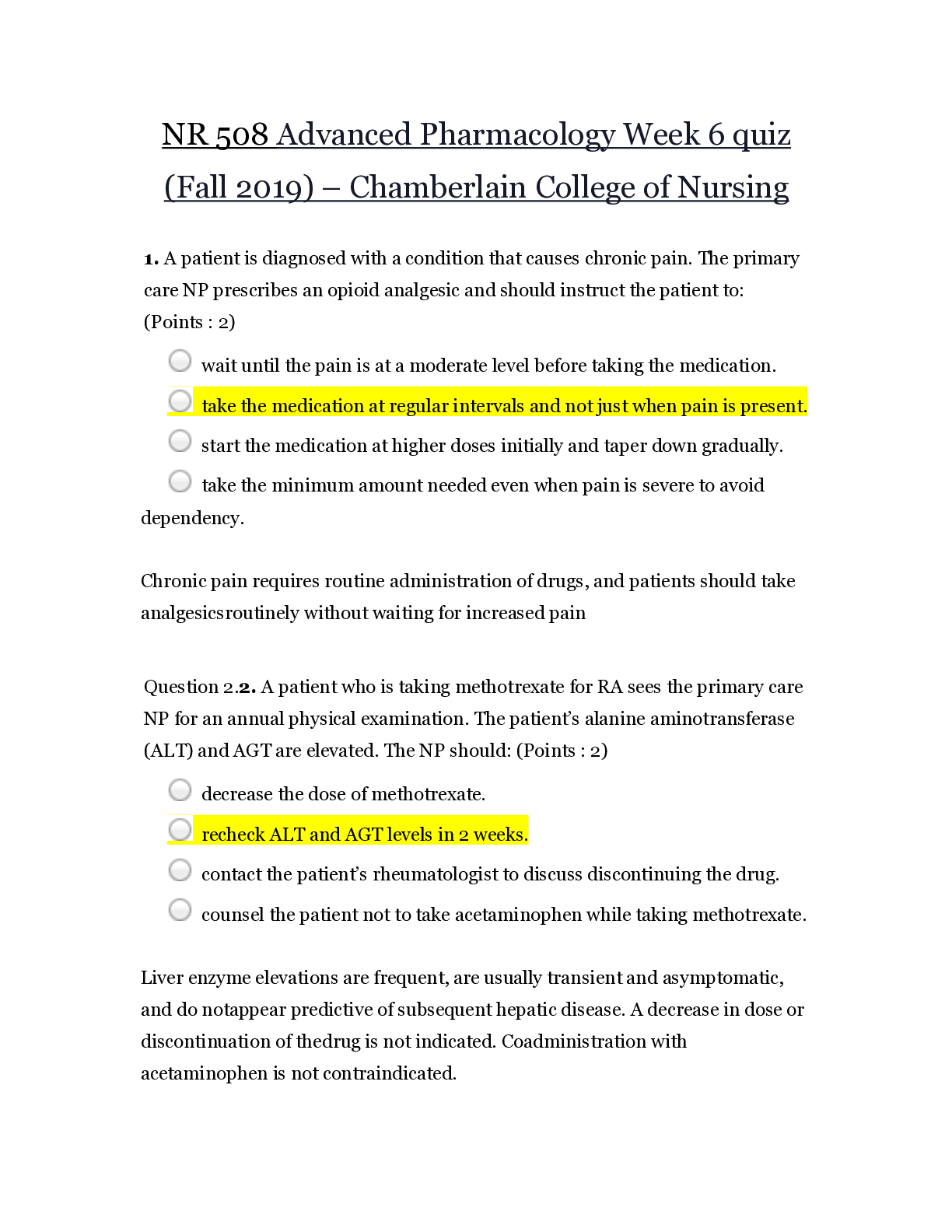
Reviews( 0 )
Document information
Connected school, study & course
About the document
Uploaded On
Jun 02, 2020
Number of pages
12
Written in
Additional information
This document has been written for:
Uploaded
Jun 02, 2020
Downloads
0
Views
45














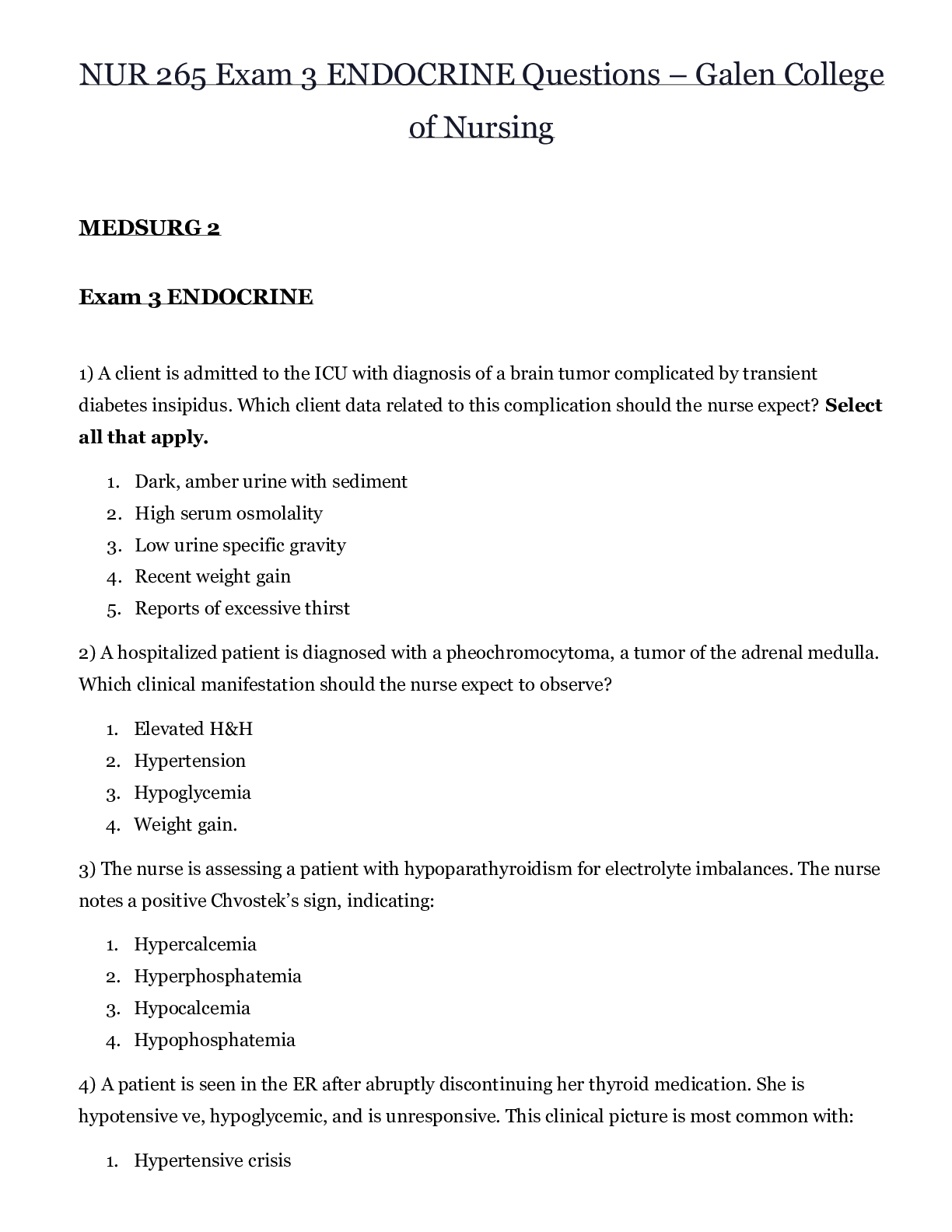
 – CHAMBERLAIN COLLEGE OF NURSING.png)
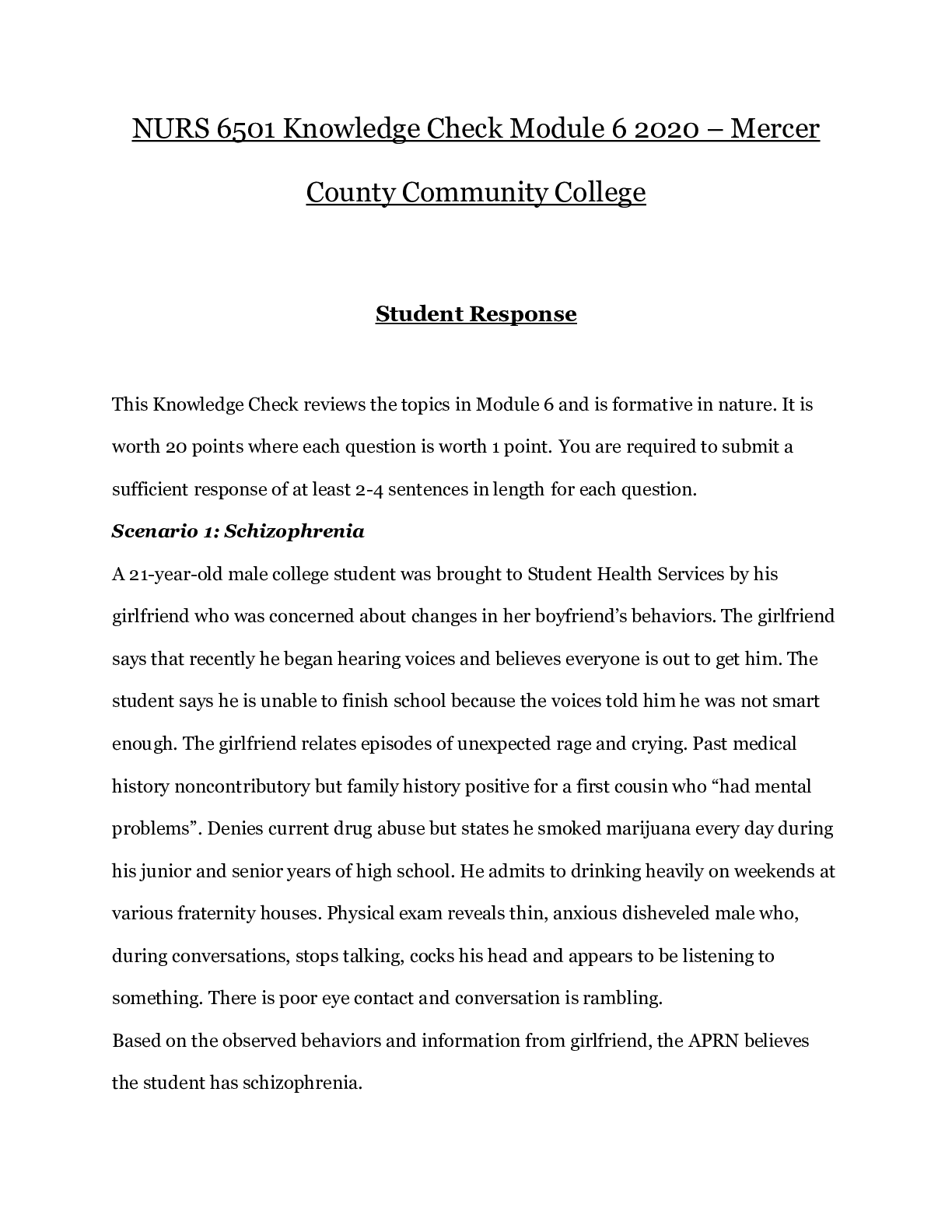


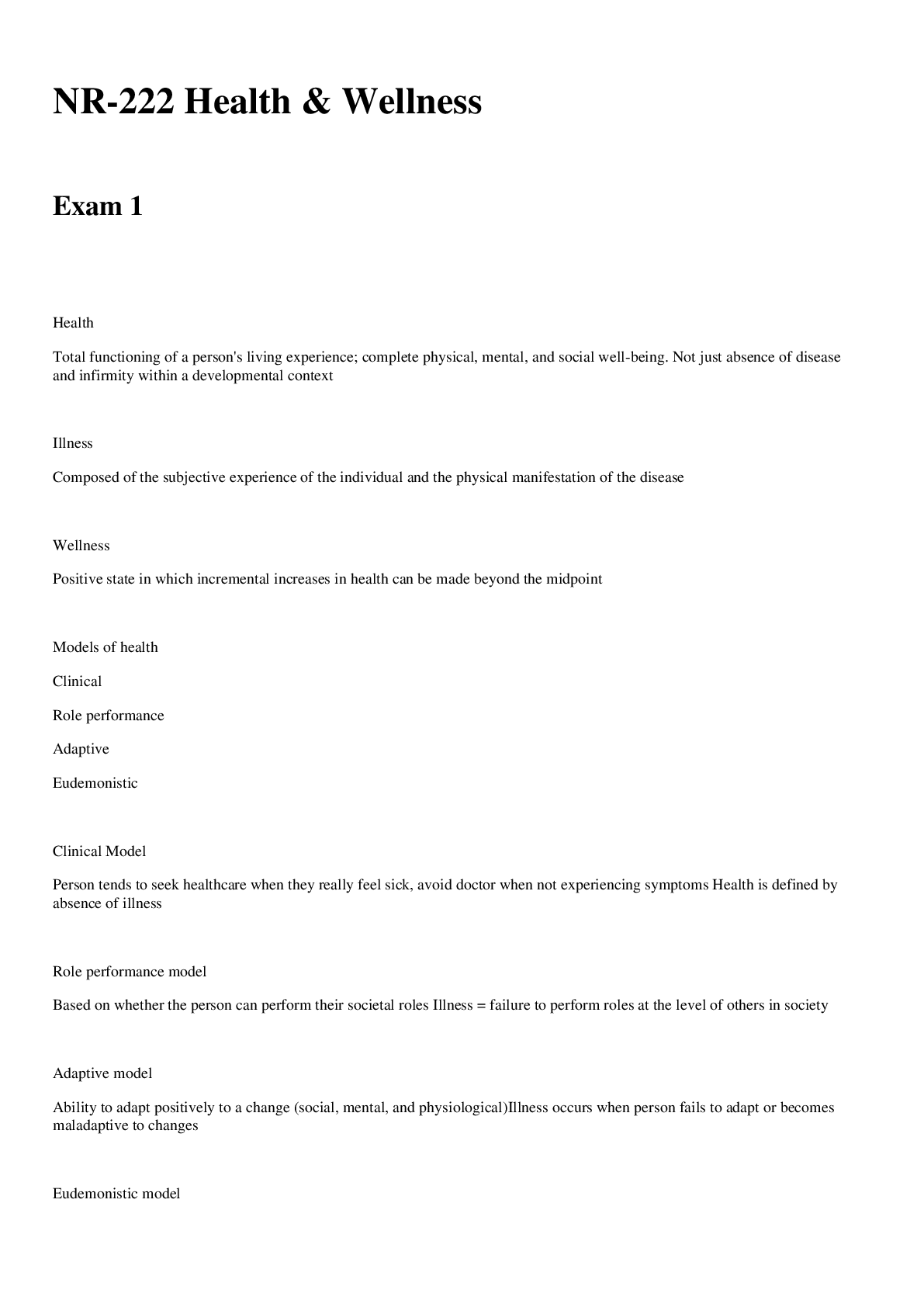



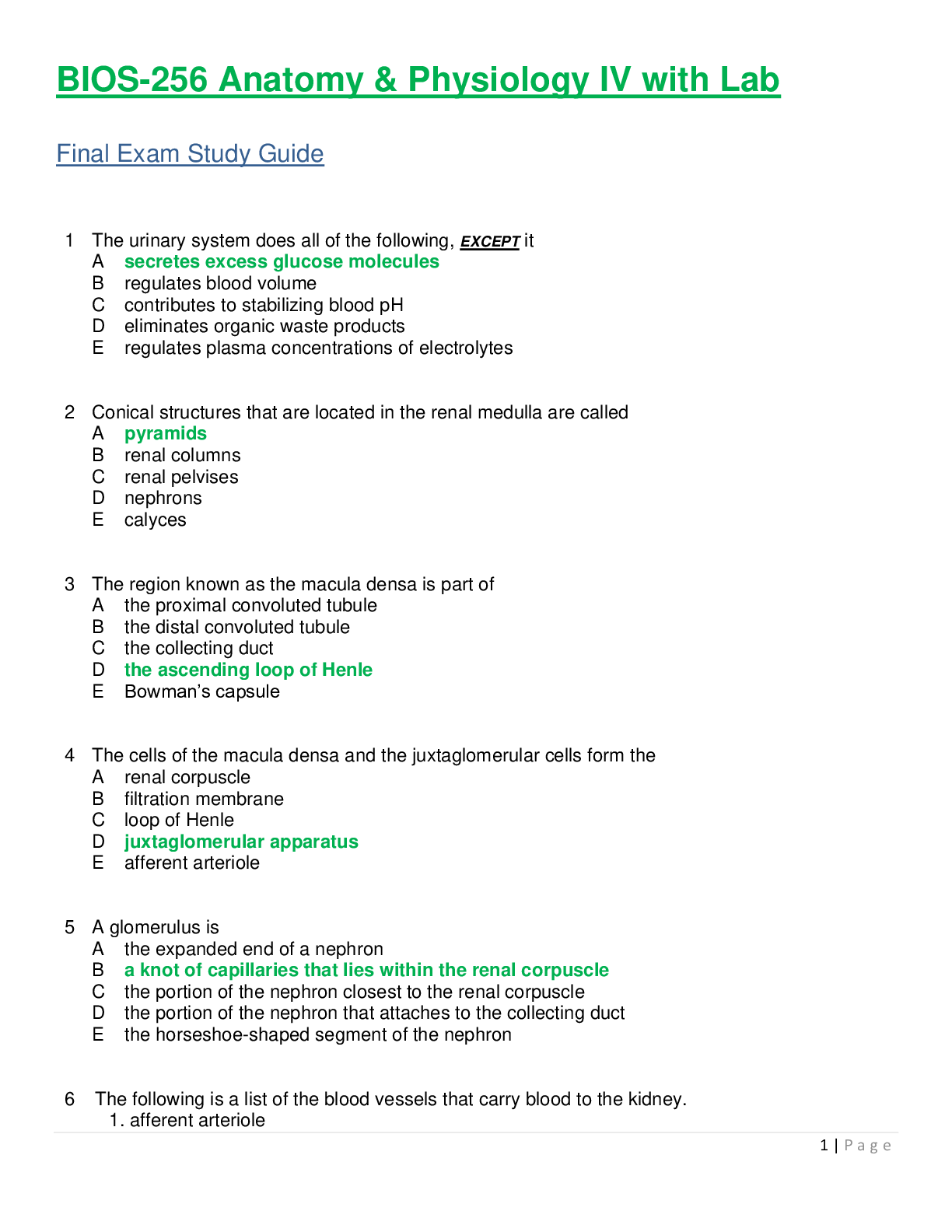

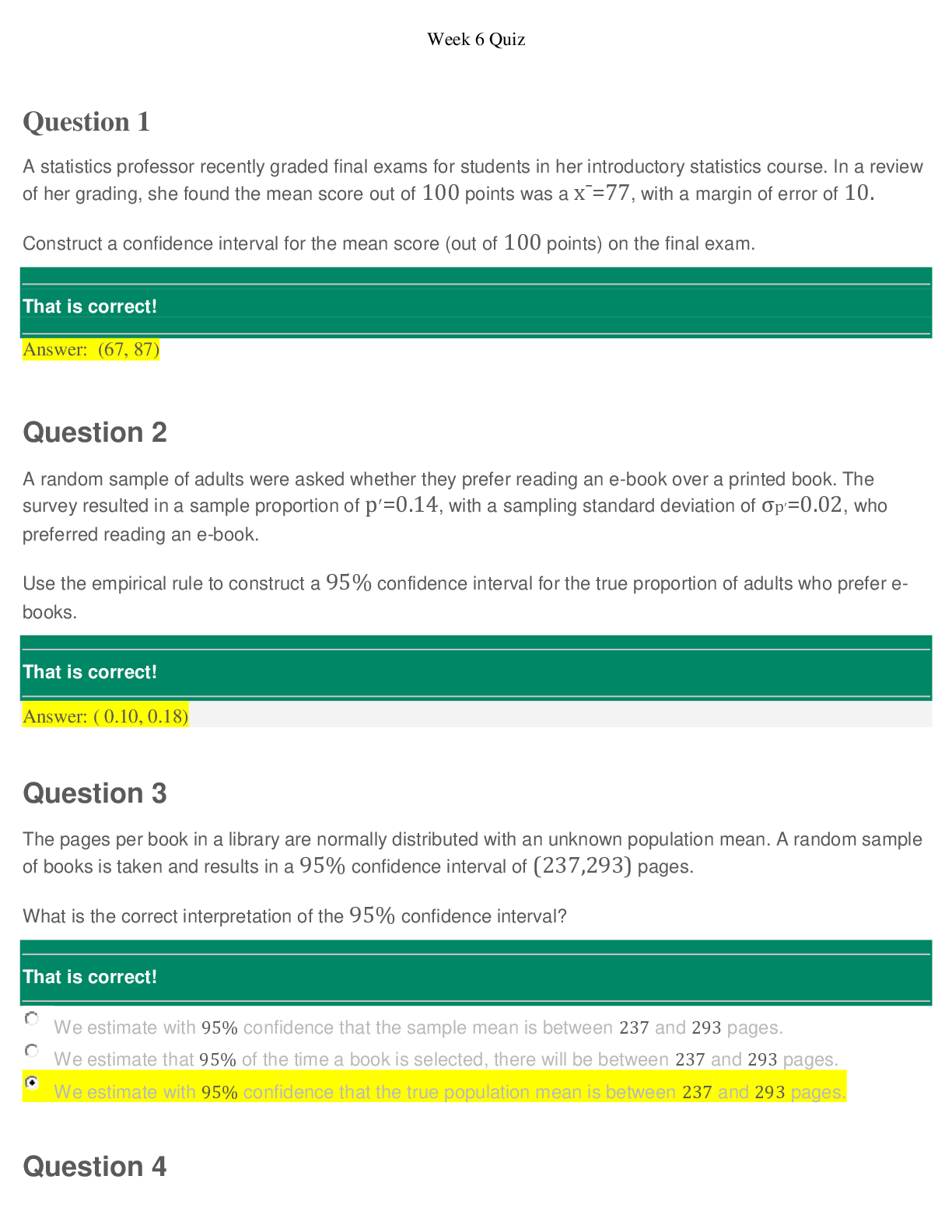



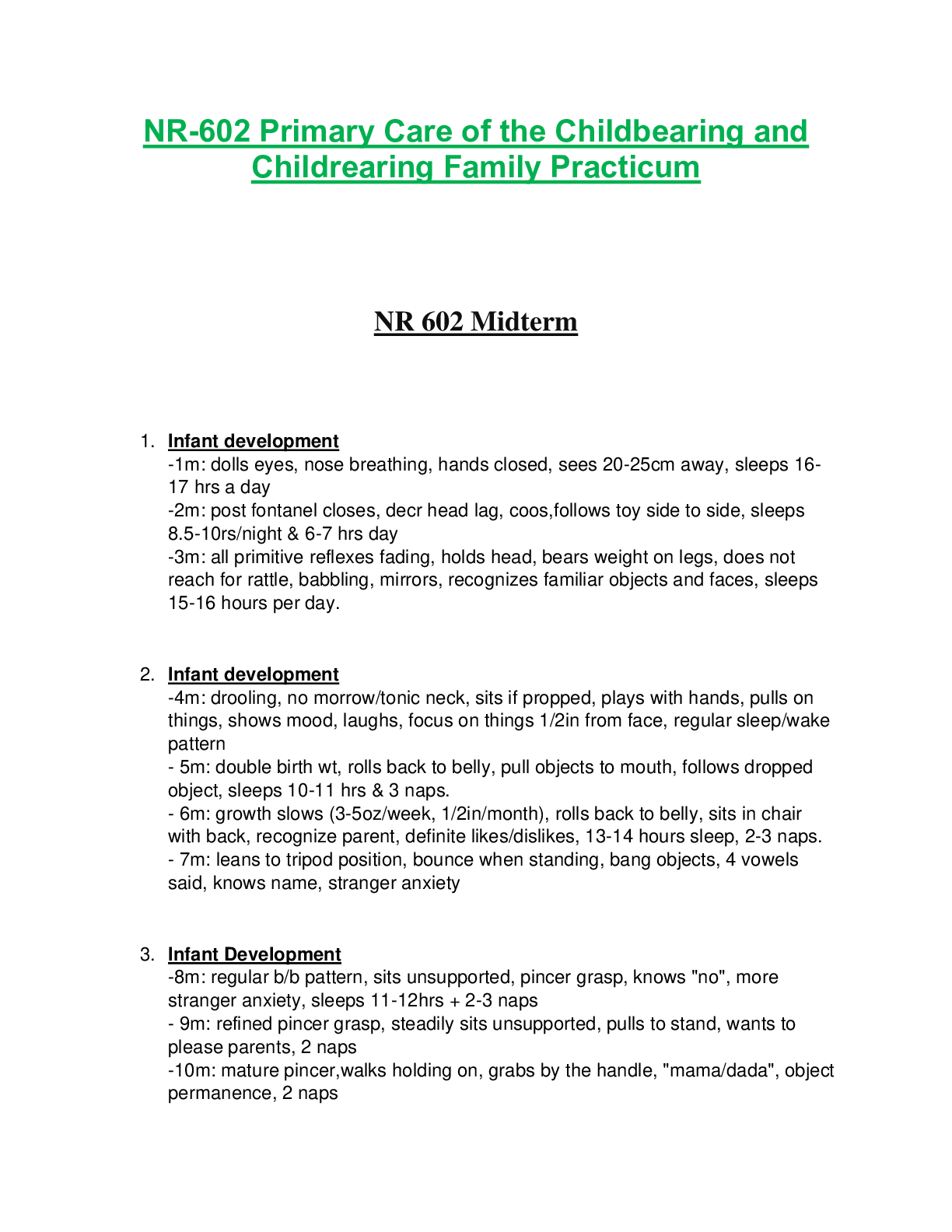
 – Chamberlain College of Nursing.png)

